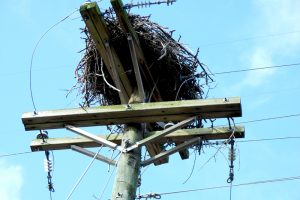By Jeff Nichols
Each year Ospreys build their nests often on top of utility poles, buildings, homes and other places that could cause damage to the structures and injure or kill the birds. Since these birds of prey mate for life and build their nests in the same place, or as close as they can to the same place year after year, the cost of loss of power, fires and the bird’s life itself grows. Many times utility workers will find a nest atop a pole, remove it (if it doesn’t contain eggs or fledglings) only to see the osprey return to rebuild immediately after the workers leave. Their natural instincts result in Ospreys being very tenacious and not easily deterred from their attempts.

—Osprey nest built on top of a utility pole. Notice the twigs hanging down close to the wires. Photo by Mike Nichols
By encouraging the birds to build their nests in alternate areas, therefore voiding these hazards and helping to prevent the osprey from being injured or killed. This often includes loss of power and ultimately increasing costs to residents and utility companies if damage occurs because of the nesting birds.
Mike Nichols. Superintendent of a utility company and 35 years of working in the electrical industry, has come up with an idea to deter the osprey from building on structures that could cause problems.
“As a superintendent of electric for a utility company I experienced the problems that the nesting Ospreys brought with them,” Nichols said. “Our efforts of trying to deal with the problem by purchasing items to deter the building of the nests had little to no success. The cost of the damages and of these failed devices each year continued to rise so I set out to attempt to design something to help with the problem.”
Nichols’ new product “OFF” – Sprey, Raptor Deterrent keep the ospreys from being able to sit directly on top of the poles and build their nests. Generally the Osprey will drop the material for the nest while hovering above the site and then land to place the material for the formation of the nest.
“In my workshop at home, I came up with the design that is now the “OFF” Sprey Raptor Deterrent and my utility has had great results from its use,” he continued. “The device can be used virtually on all types of construction standards and can be easily and quickly installed. It is made of dielectric materials and poses no potential harm to the Osprey or the environment.”
With the use of this device it eliminates the need for unnecessary human contact allowing the failed efforts of the Osprey to be the discouragement as-well-as the encouragement needed for them to find a alternate location for their nests while removing any hazards. Generally, there are natural sites available that the birds can utilize as alternates and oftentimes utility companies will provide manmade structures for the birds to build their nests.

—The “OFF” – Sprey Raptor Deterrent restricts the area an Osprey has to build the nest and the flexible tubing makes an unsteady perch. Photo by Mike Nichols
The device keep the Raptors from having a unobstructed opportunity to drop the debris and usually will be deflected away from the target site. The idea that ospreys do not like tight, confined areas along with the flexible tubing makes it nearly impossible for the birds to get near the arms of the poles and construct their nests. It also prevents the birds from getting too close to live electrical wires while landing or taking off where they could be killed or injured as you can see on this video of an Osprey trying to build a nest.

